Bichon frise
MENTALITET
En bichon frise er livlig og glad for at lege, hengiven og venlig over for alle i familien samt over for fremmede og andre hunde. Det er en kvik, lille selskabshund både i den aktive familie og hos ældre med en mere stilfærdig hverdag. En bichon frise er selvbevidst og charmerende med en veludviklet evne til at sno sin ejer omkring sin pote.
En bichon frise elsker raske daglige gåture, men er ikke specielt motionskrævende. Den sætter stor pris på nye indtryk og på at løse mentalt stimulerende opgaver i samarbejde med sine mennesker.
AKTIVITETSNIVEAU OG HANDLERADIUS
En bichon frise er mere robust, end den umiddelbart ser ud til. Den har altid været holdt som selskabshund, og den har det absolut bedst i selskab med sine mennesker, som den knytter sig tæt til. Den er lydhør og bevæger sig sjældent langt væk fra sin ejer.
PELS OG PLEJE
Pelsen er fin og silkeagtig med meget løse og lette proptrækkerkrøller. Den er den eneste bichonvariant med underuld. Pelsen skal hver dag børstes omhyggeligt igennem, og den skal vaskes ofte. Hoved og poter klippes i facon. Tænderne skal jævnligt renses for tandsten.
TIPS OG TRICKS TIL INDLÆRING OG HÅNDTERING
En bichon frise er opmærksom og lærevillig, så opdragelsen volder sjældent problemer. Vær venlig, konsekvent og opfindsom med belønningerne. Væn tidligt hunden til at blive puslet om, så den omfattende pelspleje bliver til glæde for begge parter.
FARVER
OPRINDELSE
Formentlig er de små hvide hunde fra landene rundt om Middelhavet oprindelig dværgformer af de tidlige apporterende jagthunde, som også danner basis for nutidens pudler. Bichon frisé kan føres tilbage til de kanariske øer i 1400-tallet, og den blev en overgang kaldt tenerifehund. Interessen for den aftog i slutningen af 1800-tallet, og den blev næsten glemt, indtil den i mellemkrigsårene blev "genopdaget" af belgiske og franske opdrættere. I dag er den en populær selskabshund verden over.
INTERNATIONALT RACENAVN
Bichon a Poil Frisé.
Bichon frise HVALPE TIL SALG
VISER 2 ANNONCER
Herunder finder du en oversigt over aktuelle kuld af racen Bichon frise, der pt. er til salg.
Husk også at læse guiden til, hvad du skal være opmærksom på, inden du køber hund.
Bichon havanais
MENTALITET
Bichon havanais er en lille og livlig selskabshund. I familien er den elskelig, hengiven og meget optaget af at lege med familiens børn. Den har et charmerende væsen og er altid oplagt til narrestreger. Den er opmærksom og alarmerer om alt, hvad den finder usædvanligt. Den lange pels kræver en betydelig indsats med børste og kam.
Bichon havanais har brug for meget nærhed og god social kontakt med familien. Den trives dårligt med at være alene for længe ad gangen. Den elsker friske gåture med nye indtryk og positive oplevelser
AKTIVITETSNIVEAU OG HANDLERADIUS
Bichon havanais er tæt knyttet til sine mennesker og bevæger sig sjældent langt væk på eget initiativ. Den er lydhør og reagerer generelt godt på anvisninger, også når den får lov til at bevæge sig frit. Jagtinstinktet er minimalt og tager sjældent overhånd.
PELS OG PLEJE
Den 12-18 cm. lange pels er blød, glat tilliggende eller bølget. Underulden er sparsom og kan helt mangle. Pelsen må aldrig klippes eller rettes til undtagen på poterne, hvis hunden skal udstilles. Pelsen skal børstes flittigt for ikke at filtre.
TIPS OG TRICKS TIL INDLÆRING OG HÅNDTERING
Fra tidligste hvalpealder bør Bichon havanais vænnes til den noget omfattende pelspleje, så soigneringen bliver en hyggestund og ikke en magtkamp. Opdragelsen volder sjældent problemer, da hunden er glad for kontakt og sætter stor pris på opmærksomhed.
23-27 cm for begge køn ifølge racestandarden. (21-29 cm tolereres)
4,5 - 7,5 er idealvægten for racen.
Sjældent fuldstændig rent hvid, fawn i alle afskygninger, sort, grå, havannabrun, tobaksbrun og rødbrun. Der tillades aftegninger i de nævnte farver.
OPRINDELSE
Bichon havanais stammer fra det vestlige middelhavsområde og er oprindelig udviklet langs de spanske og italienske kyster. Den er formentlig tidligt kommet til Cuba med søfolk på langfart. De små hunde var efterspurgt af øens velbjergede damer, så de blev brugt som bestikkelse eller som handelsvare. Bichon havanais levede ubemærket på Cuba til langt ind i 1900-tallet. Forholdene på Cuba betød dog, at den forsvandt fra øen, men cubanske flygtninge bragte den til USA, hvorfra den blev spredt ud over verden.
INTERNATIONALT RACENAVN
Bichon havanais HVALPE TIL SALG
VISER 12 ANNONCER
Herunder finder du en oversigt over aktuelle kuld af racen Bichon havanais, der pt. er til salg.
Husk også at læse guiden til, hvad du skal være opmærksom på, inden du køber hund.
Bichon Havanaise , hund, 6 år
Bichon Havanaise , hund, 6 år , salgklar 18/2-18
Reserveret til fredag.
Efter lang tids overvejelse, har jeg nu besluttet at finde et nyt hjem til min dejlige Hollie.
Hollie er en 6 år gammel Bichon Havanaiser. Hun er en skøn hund, som er fuld af kærlighed.
Grunden til, at jeg desværre må sige farvel til min lille ven er, at hun desværre ikke passer til min levemåde. Og det er for synd for hende.
Jeg søger derfor et nyt dejligt hjem til Hollie.
Jeg håber at finde nogen hjemmegående, eller nogen som er meget hjemme, da Hollie elsker selskab, og har det bedst derhjemme i vante rammer. Og helst med egen have. Gerne på landet, da hun godt kan gø, når der går nogen på fortorvet udenfor haven.
Hollies gode sider:
- Elsker at gå ture. Især i hundeskoven, hvor hun kan løbe frit.
- Elsker at hygge og putte i sofaen, og blive kløet på maven.
- En tro følgesvend.
- Kan være alene hjemme.
Hollies mindre gode sider:
- Ikke så glad for andre hunde. Gør, hvis vi møder nogen på gåture, da hun bliver nervøs. Ved hunde hun kender, kan hun dog ikke komme hurtigt nok hen og hilse.
- Bliver stresset ved for lang transport/rejser med tog osv.
Hollie har det bedst, hvis hun er meget sammen med sin ejer, og ikke skal med rundt. Hun er en skøn hund, som jeg derfor håber, kan få det bedre et andet sted, da jeg arbejder for meget, og indimellem har brug for, at have hende med rundt. Og det gider hun ikke.
Er der mon nogen, som vil kunne give min lille hund et godt hjem.
Der medfølger alt hendes grej. Hundekurv, transport kasse, børste, shampoo, sele, legetøj, hendes tæpper, godbidder osv.
Hun er lige blevet klippet, og ellers har hun en fin krøllet pels.
Vi bor i Lyngby.
Tager 3000 kr. for Hollie. Så jeg ved at det er en, som har råd til, at have hund.
Bichon. havanais, hund, 2 år
/s-l960.jpg" />  Se alle 8 billeder i fuld størrelse
Se alle 8 billeder i fuld størrelse
Bichon. havanais, hund, 2 år
Med grædende hjerte har vi taget beslutningen, at Anton skal finde et nyt hjem. Vi har ikke travlt med at komme af med ham.
Smukke Anton er af farven Black and tan og er i kort bamse klip. Han er 1 1/2 år, han har boet hos os siden han var
8 måneder. Men vi må indrømme, hvor ondt det end gør, at vi ikke kan beholde ham. Han har ikke stamtavle men begge hans forældre har. Han er renlig, kommandoer han kender er sitte, dække, giv pote.
Anton elsker vores familie men er usikker ved nye mennesker og andre børn lige i starten. Vi er en familie med 3 børn, som han elsker, men han kan desværre ikke lide pludselig og vilde bevægelser, og med legekammerater vi ofte har, synes vi det er synd at da det stresser ham.
Han er ikke pjattet med at være alene, dette er i form af at kan finde på at gø, og da vi camperer en del, udgør det et problemstilling for os alle. Vi har en dejlig hun hund som han elsker de leger fantastisk sammen, men andre hunde kan ikke komme for tæt på. Vi tænker det hører samme med hans usikkerhed.
Anton elsker sine gå ture, er det virkelig noget han udstråler stor glæde i.
Han elsker generelt at være ude.
Vi ser Antons nye familie som efterlønner eller pensionist, som er færdig på arbejdsmarked, eller få arbejdstimer, således Anton får den sidste hjem med storforkælelse og alt det han fortjener.
Du/ I skal bo i hus med udgang til have. Og vil være et plus hvis Du/ I bor på landet eller i rolige omgivelser med dejlig natur. Dvs. Stor by fortrækkes ikke.
Vi vil kun det bedste for Anton.
Du skal have kendskab til ikke fældende race, det kræver pelspleje og klipning. Med mindre du benyttter hundefrisør.
Han får sin sele,snor, kurv,legetøj, tæppe med så han føler sig tryk med sine egne ting.
Han spiser specific kvalitets hundefoder vi køber hos dyrlægen.
Skriv IKKE BESKEDER PÅ DBA, men
gerne en sms, eller på mail
hvad du/ i har at tilbyde, så byder vi gerne jer til en kop kaffe, så vi kan møde hinanden.
Er fragt muligt? Spørg sælger
Send din adresse til Salli j. og spørg, om du kan få sendt "Bichon.".
From the breeders and puppy families of
Bichon Poos
love to play, love to snuggle
Bichon Frise / Poodle Hybrid
Pronounced: BEE-shon-poo
The Bichon Poo puppy is a hybrid or cross between a Bichon Frise and a Poodle. The Bichon was popular in France during the Renaissance under Francis I (1515–47), but its popularity skyrocketed in the court of Henry III (1574–89). The poodle is believed to have originated in Germany, where it was known as the "Pudelhund". Pudel (puddle), in German means "to splash about", and the word hund means dog. The breed was standardized in France, where it was commonly used as a water retriever.
description
A very “healthy puppy” with a great health history. They are very sturdy and generally low maintenance. Most Bichon Poos have a very curly, soft, and fluffy coat, which is non-shedding. They produce little or no dander, so they're great for people with allergies.
Family with young children
Family with adolescent or teenage children
Apartment / condo living
Anyone looking for a "purse puppy"
personality
Bichon Poo puppies are quite intelligent and easily trained. They are very good with children, quite tolerant of a lot of rough-housing. They are sturdy, and they enjoy being outdoors with their family. They are fun loving, but also enjoy cuddling.
size & color
Bichon Poos vary in size, depending on genetics. They mature at 9 to 15 pounds. They come in a variety of colors including cream, buff and white.
Bichon Poos need to be brushed weekly and they need to be clipped about 3 or 4 times a year. They shed very little so they are a good choice for families with allergies.
Bichon Poos are vey smart because of both the the Bichon influence and the Poodle influance. They want to please you so they learn commands quickly as long as you are totally consistent.
activity level
Bichon Poos want to do what you want them to do. They are happy chasing the kids around the backyard all day long or just as content curled up at your feet while you watch television or read a book.
we are available .
Tuesday through Saturday
11:00am to 6:00pm
All appointments are on Saturday
11:00am to 6:00pm
Sunday we are in worship with our family
Bichon hund
Vi er Bichon Frise`
Velkommen til vores
Her er hr og fru perletand
SKOVFRYDS SNOW MALENE ER DГ˜D.
FГёdt d. 18.04.2004 og
DГёd d.26.08.2015. Malenemor vil blive savnet meget,hun var en virkelig god hund.
Her er vi 8 uger,Mette og Monike til th,-Julius & Bellis er flyttet til KГёbenhavn og Fyn.
Er vi ikke sГёde
Hej jeg hedder Mette
Bichon Frise`hvalpen er sГҐ
nuttet.kik bl.a ind pГҐ pelspleje af
Bichon Frise hunde -der er ogsГҐ
opskrifter pГҐ goodbidder du selv kan lave -klik pГҐ
Bolognese Temperament: What's Good About 'Em, What's Bad About 'Em
Bolognese Temperament, Personality, Behavior, Traits, and Characteristics, by Michele Welton. Copyright © 2000-2018
The Bolognese belongs to a related family of dogs that include the Bichon Frise, Maltese, Havanese, and Coton de Tulear. These breeds have a similar appearance and very similar temperaments.
Of the group, some breeders believe that the Bolognese is the brightest thinker and problem solver.
He is also, by far, the hardest of those breeds to find.
Devoted and attentive, the Bolognese shadows his owner possessively and is such a skilled reader of body language and expression that he often appears telepathic.
Indeed, this breed doesn't do well without a great deal of companionship. If you're home all day and looking for a lap buddy, consider this breed. Otherwise, the dog will be lonely and unhappy.
Quick to learn and responsive to gentle training, some Bolognese do well in competitive obedience and agility.
If you want a dog who.
- Is small but sturdy
- Is polite (though often cautious) with people and other animals
- Is usually long-lived
- Sheds very lightly (often a good choice for allergy sufferers)
A Bolognese may be right for you.
If you don't want to deal with.
- "Separation anxiety" (destructiveness and barking) when left alone too much
- Shyness or suspiciousness toward strangers when not socialized enough
- Frequent brushing and combing (or clipping the coat short)
- Housebreaking difficulties (this whole family of breeds can be difficult to housetrain)
- Tendency to bark when he sees or hears things
- Waiting lists (very hard to find)
A Bolognese may not be right for you.
Keep in mind that the inheritance of temperament is less predictable than the inheritance of physical traits such as size or shedding. Temperament and behavior are also shaped by raising and training.
- You can avoid some negative traits by choosing an ADULT dog from an animal shelter or rescue group. With an adult dog, you can easily see what you're getting, and plenty of adult dogs have already proven themselves not to have negative characteristics. Unfortunately this is better advice for other breeds, since Bolognese are so rare that you're unlikely to find one for adoption.
- If you want a puppy, you can avoid some negative traits by choosing the right breeder and the right puppy. But you usually can't tell whether a puppy has inherited temperament or health problems until he grows up.
- Finally, you can avoid some negative traits by training your Bolognese to respect you and by following the 11-step care program in my book, 11 Things You Must Do Right To Keep Your Dog Healthy and Happy.
More traits and characteristics of the Bolognese
If I was considering a Bolognese, I would be most concerned about.
- Potential separation anxiety. More than most other breeds, Bolognese need a great deal of companionship and do not like being left alone for more than a few hours. They become anxious, which they express by chewing and barking. If you work all day, this is not the breed for you.
- Grooming. Without frequent brushing and combing, Bolognese become a matted mess. If you can't commit to the brushing, you have to commit to frequent trimming or clipping to keep the coat short and sanitary.
- Housebreaking problems. This entire family of dogs (Bolognese, Havanese, Maltese, Bichon, and Coton) is slow to housebreak. Consistent crate training is mandatory. Sometimes a doggy door is necessary to give the dog immediate access to his potty area.
- Potential barking. Bolognese are often too quick to sound the alarm at every new sight and sound. You have to be equally quick to stop them.
- Providing enough socialization. Standoffish by nature, Bolognese need extensive exposure to people and to unusual sights and sounds. Otherwise their natural caution could become shyness or suspiciousness, which are difficult to live with.
- Finding one and paying the price. Expect a very long waiting list and a price tag well over a thousand dollars.
To help you train and care for your dog
Dog training videos. Sometimes it's easier to train your puppy (or adult dog) when you can see the correct training techniques in action.
To learn more about training your dog to be calm and well-behaved, my dog training book is Teach Your Dog 100 English Words. It's a unique Vocabulary and Respect Training Program that will teach your dog to listen to you and do whatever you ask.
My dog buying guide, Dog Quest: Find The Dog Of Your Dreams, will teach you everything you need to know about finding a good-tempered, healthy dog.
My dog health care book, 11 Things You Must Do Right To Keep Your Dog Healthy and Happy, shows you how to help your dog live a longer life while avoiding health problems and unnecessary veterinary expenses.
MORE OF MY ARTICLES YOU MIGHT ENJOY.
What Works, and What Doesn't
Is The Best Food
Copyright © 2000-2018 by Michele Welton. All rights reserved. No part of this website may be copied, displayed on another website, or distributed in any way without permission from the author.
adams hundeblogg

Akkurat når du tror du har fått alle hunderaser funnet ut, ta deg en titt på en hund som ser ut som en maltesisk og finne ut at det ikke er en maltesisk i det hele tatt – det er faktisk en Bichon Frise. Fantastisk! Mer tid på å studere hunderaser er klart til orde for, noe som betyr at du får til å utvide din kunnskap om kjæledyr bare litt mer.
Ok, liker så kanskje ikke alle leksene. Med det i tankene, la oss få det ut av veien og fokus på dette nysgjerrig hund kjent som Bichon Frise, fransk for “krøllete hvit lap hund.” Hey, den franske er ingenting om ikke litt bokstavelig.
Denne hunden kan betraktes som en stor leken hund, og mens det ser ut som den maltesiske, har noen forskjeller som gjør det en rase i seg selv. Og selv om fluffy hvit frakk kan skremme potensielle hundeeiere som ikke liker tanken på en masse pelsstell, er Bichon Frise raskende lite vedlikehold, noe som betyr at de ikke er store shedders og vil ikke være en kurv ved at romkamerat av deg med hunden allergi.
Overbevist om at Bichon Frise er en unik rase verdig studien ennå? Good. Fordi vi er i ferd med å sette fokus på de individuelle egenskapene til denne franske rasen som vil hjelpe deg å forstå hvorfor så mange mennesker går rundt med maltesiske utseende hunder som faktisk har alle de positive kvaliteter som andre raser, Bichon Frise.
Bichon Frise er, forutsigbart, en fransk rase. Som du glimt fra roten ordet “Bich”, navnet på hunden har sin rot i helt bokstavelig og gamle franske oversettelser. I likhet med maltesisk, de ulike Bich raser kom fra Middelhavsområdet og har en lang historie i hele Europa og europeisk handel. Sjømenn ville bringe lignende raser rundt med dem, og takket være sin munter personlighet, disse hundene ville bli en hit, spesielt på steder som Spania. Senere, italiensk adel funnet disse rasetypene for å være veldig hyggelig og ingen tvil ga dem god rundetid.
Denne bakgrunnen i seiling kan fortsatt være bevis som rasen kan noen ganger nyte svømming og apportering, selv om Bichon Frise er absolutt ikke en jakt eller henting hund. Gjennom historien har Bichon Frise nøt fransk oppmerksomhet fra domstolene i Napoleon III til gatene i Paris. Rasen ble formelt anerkjent i de siste århundrene like mange hunderaser har vært.
The Water Spaniel og Puddel likne Bichon Frise og det er ikke rart: de kan betraktes to forfedre til Bichon Frise. Den Barbet Spaniel – noen ganger et annet navn for vannspaniel – bør bemerkes, som du kan finne noen artikler som refererer til denne stamtavle.
Hunden fant en rekke boliger over aldre i land som Spania, Frankrike og Italia, og har selv reist til Kanariøyene før de blir transportert tilbake til det europeiske hjemland. Disse rasene – som den maltesiske og Bichon Frise – har hatt et rikt og variert historie som en favoritt til adel og kongelige så vel som de mer vanlige klasser i hele Europa. Deres munter personligheter har vært en favoritt selv fører inn i moderne tid.
Whole Foods inkludert gode kjøttstykker er stor for Bichon Frise. Det kan være lett å ødelegge dem, men sørg for at de får en jevn diett av hele, naturlig mat som de vil være i stand til å nyte. Ikke over mate dem.
Generelt er Bichon Frise en bekymringsfri hund i form av dressur, kanskje en grunn til at de var så populære i trading verden av Europa hvor det ville være enkelt å skaffe seg en hund og akklimatisere det til ventures som seiling og barte. Det kan kreve litt tålmodighet til å håndtere den Bichon Frise hvis du er en første gang hundeeieren, men riktig dressur vil gå en lang vei i denne rasen. Å være sikker på å sosialisere denne hunden med andre hunder tidlig er en god idé.
Større enn den maltesiske i mange tilfeller bør Bichon Frise veie alt 10-20 pounds, avhengig av sin samlede rammen og muligens sitt kjønn. Dette er en liten hund passer for runder, og hvis du merker at hunden føler seg litt for tungvint på fanget mens du ser på TV, så kan du være ganske sikker på at du får lyst til å gi hunden mer mosjon.
Munter og energisk, Bichon Frise var en favoritt med gamle europeiske sjømenn akkurat som de er i hjem over hele Europa og Amerika i dag.
La oss snakke om din helse for et øyeblikk: Bichon Frise er ansett som et allergivennlig hund som har vært avlet for å fungere godt sammen med mennesker som er allergiske. Men det er viktig å bruke tid rundt en Bichon Frise å forstå at det ikke la noen hår rundt til tross for sitt rykte som et ikke-shedder.
I form av sykdoms tilbøyeligheter, autoimmune sykdommer herjer denne rasen, så det vil være viktig å spørre din veterinær om advarselen tegn på sykdommer i Bichon Frise.
Leve rundt 12-13 år med et sunt liv er typisk for denne type og størrelse på hunden.
Regelmessig mosjon og lek bør være en daglig diett for Bichon Frise. Gir det rikelig med sosial interaksjon på samme tid er alltid et pluss for å holde kjæledyr humør godt regulert og stabil.
Oppføring Bichon Frise som “glad og lykkelig,” American Kennel Club notesthat denne rasen er en “naturlig mild, leken hund.”
Pelsen av Bichon Frise kan faktisk være et tema for debatt, for eksempel mengden av pelsstell er nødvendig. Det er lurt å holde dette hvite, puffy frakk velstelte og riktig børstet, men hunden er ikke en rase som vil kaste hele teppet, heller.
Lekent og energisk selv som voksne, må du huske å gi valpene nok av tid og rom til å utforske, men ikke la det gå over til å bli altfor selvstendig. Pass på å sosialisere disse hundene tidlig med veloppdragne hunder fra nabolaget ditt.
Bichon hund
Shichon Dogs.com is here to offer puppy parents everywhere information about our wonderful breed. Our breed has many different names, they can go by zuchon dogs, teddy bear dogs, rag doll dogs, lap rug dogs, and as we call then fuzzy wuzzy dogs.
We have been breeding shichon dogs since 2004, and we take great pride in our breeding programs. We are always here to help puppy parents make an educated choice when it comes to adding a puppy to their family. It is not a decision to be taken lightly. After all you are adding a new member to your family. You will be responsible for them for the next 15 years. Our main website offers great information about shichon dogs and shichon puppies, Take your time thru our site, it may seem to be overwhelming but it is designed to help you make the right choice for you and your family. If you ever have any questions please don't hesitate to give me a call or send me an e-mail.
Shichon Dog Information
Shichon dogs are a hybrid which is a combination of two different pure-breeds. It's a cross between a Bichon Frise and a Shih Tzu . The best way to understand what type of dog your Shichon will be is to read both of its ancestors descriptions and understand that any combination of characteristics could be present in your pet. Some Shichon dog breeders are breeding multi generation shichon dogs. Here are the examples
Shih Tzu Bred to Bichon = F1----the most common
Shih Tzu Bred to Shichon = F1B--second most common
Bichon Bred to Shichon = F1B
Shichon bred to Shichon= F2
General Description
The Shichon takes its appearance from both breeds. For the most part, the Shichon will have a double coat that has an outer coat which is loosely curled and fluffy and an undercoat that is fine, soft and silky. The undercoat of this breed will usually be between three and four inches in length. For the most part, this breed is considered to be hypo-allergenic because it does not shed much, they have hair and not fur. The colors of the Shichon will vary based on the colors of the parents. But many of them do lose their color as they get bigger, especially the first generations F1. . Many turn almost white like the Bichon Frise, but they may look like the shih tzu as a puppy and change as they mature.
Here is an example:
Benny at 12.5 weeks
Benny at 1 year old
The Shichon is known for inheriting some of the best qualities from both parent breeds. They tend to be spunky and alert and love to play. They are also very affectionate and crave being with people. They become devoted to their families and do not do well when separated for long periods of time. They want to be with their people as much as possible. We have had SEVEN of them become certified therapy dogs. This breed is typically good with other pets, especially when socialized at an early age. This dog gets along well enough with children, but it may be a good idea to socialize this breed at an early age as well as to supervise play time with children to make sure that the dog does not get hurt as a result of its small size.
Owners should be aware that the Shichon tend to be intelligent and is also independent and bold. They are easy to live with and are typically easy to train. They get along with practically everyone, although they do make fairly good watch dogs. When necessary, this dog will bark to alert its family that someone is nearby, but this dog is not one that will usually bark excessively.
Most shichons will be in the 9-12in range, but they may be a little bigger or a little smaller depending on the history behind their parents. You need to look at 5 generations behind them to determine their true size, and sometimes they will fool you, by getting bigger then you thought and bigger then mom or dad, then on the other hand they might stay smaller then their parents. That is why it is very important to know the history behind their mom and dad.
The full grown weight of the shichon dog can be any where from about 8lbs to 25lbs. depending on the the genetics behind the parents. Again you need to look at 5 generation behind the parents to determine the size they can be. Most of our shichons tend to be in the 12-14lb range our smallest being 6lbs our biggest being 22lbs.
The average life expectancy of the Shichon tends to be about 15 years, provided that it is given good care and receives regular check-ups. The Shichon can suffer from any health issue that is known in the Shih Tzu breed or the Bichon breed. But because the Shih Tzu and Bichon do NOT share the same health concerns you are most likely to have fewer health issues. If one of the parents have a health issue the puppy is mostly to inherit it. If a prospective owner is concerned about possible health problems, it is a good idea to check the parentage of the dog to determine whether there may be serious health problems possible.
Shichon puppies were bred specifically to bring out the best of both of the parent breeds. The Shichon as a designer breed has become popular in the last few years and is valued as a family and companion dog.
The Shichon does not have a lot of significant maintenance issues. For the most part, this dog will manage to take care of its exercise needs on its own. That said, this breed of dog will enjoy being taken out on walks and will enjoy playing out in the open, provided that it is given appropriate supervision. The coat of the Shichon will require regular brushing and the dog will need to be bathed when necessary to keep the coat healthy and clean. Generally, the Shichon is not a heavy shedder, so there are usually not any concerns in that regard, which is one reason why this dog is so popular with families with allergies
The best environment for the Shichon will be one in which it can live indoors with its family and have playtime on occasion outside. This is not a dog that will do well on the outside. It is well suited for apartment life considering that it is small, can get sufficient exercise on its own and does not bark excessively. It gets along well with children as well as with other dogs. Training may be a good idea for this breed, not because of poor behavior, but because the dog is intelligent and loves to learn and please its owners. Due to the fact that this dog enjoys being with humans so much and craves affection, this is not a dog that will do well in an environment where it will be left alone for long periods of time.
Shichon Photos
Pros: Very loving, smart, cuddly ,non shedding,
Cons: need to be brushed daily, groomed often
This website was created By www.fuzzywuzzypups.com on 2/28/2011
LOOKING FOR A SHIH TZU BICHON MIX? Check out the links and information below
Havanese
Information and Pictures
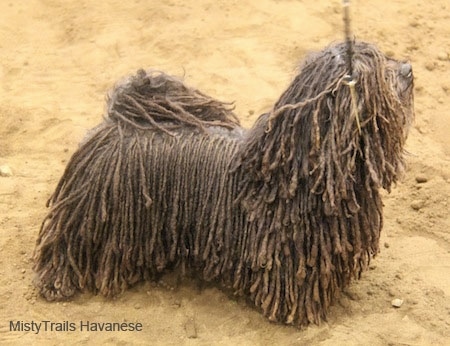
Corded Havanese MBIS CKC Grand Ch. Ex/AKC/Intl Champion Eddie Murphy at MistyTrails CGN, #1 Dog in Canada. Photo courtesy of MistyTrails Havanese Aug 2012
Other Names
Havana Silk Dog
Pronunciation
ha-vuh-NEEZ
Your browser does not support the audio tag.
Description
If never primped, clipped or altered in any way, the Havanese gives a rugged impression in a little dog. The legs are strong and allow for free and easy movement. The dark eyes and long tail are covered with long, silky hair. The profuse coat varies from wavy to curly to corded. The corded coat is recognized by both the AKC (American Kennel Club) and the CKC (Canadian Kennel Club). The Havanese is a double-coated breed with soft hair, both on the outer coat and undercoat. The adult coat reaches 6 to 8 inches, and has a pearly sheen. Some Havanese carry a shorthaired recessive gene. If two adults with this recessive gene have a litter of puppies, it is possible that some of the puppies will be born with smooth coats. A Havanese with a short coat cannot be shown, as it is a serious fault in the show arena. Some have nicknamed the Havanese born with short coats Shavanese. Eye rims, nose and lips are solid black on all colors except the true chocolate dog. The Havanese comes in any color, including cream, gold, white, silver, blue and black. Also parti and tricolor. In North America, all colors are recognized; no preference is given to one color over another. Black and chocolate are preferred colors with many North American breeders. A chocolate Havanese must retain at least a 1 inch (2.6 cm) patch of chocolate hair. Chocolates also have green or amber eyes. In some European countries the black and chocolate dogs were not always recognized, but the black dogs have been recognized for several years, and the chocolate dogs are now recently recognized. The gait is unique, lively and ”springy," which accentuates the happy character of the Havanese. Tail is carried up over the back when gaiting. The breed is of solid physical type and sound constitution. The Havanese is sturdy, and while a small breed, it is neither fragile nor overdone.
Temperament
Havanese are natural companion dogs, gentle and responsive. They become very attached to their human families and are excellent with children. Very affectionate and playful with a high degree of intelligence, these cheerful dogs are very sociable and will get along with everyone including people, dogs, cats and other pets. They are easy to obedience train. This curious dog loves to observe what is going on. It is sensitive to the tone of one's voice and will not listen if it senses that it is stronger minded than its owner, however it will also not respond well to harsh discipline. Owners need to be calm, yet possess an air of natural authority. The Havanese has a long reputation of being a circus dog, probably because it learns quickly and enjoys doing things for people. Few tend to bark a lot, as they can be taught not to do this; it is not their nature to bark a lot. It is best to teach them not to bark unnecessarily while they are still young to prevent it from becoming a habit. Havanese are good watch dogs, making sure to alert you when a visitor arrives, but will quickly welcome the guest once it sees you welcome them. Some dogs that have not been properly socialized may exhibit a degree of shyness around strangers, but this is not characteristic of the breed. Havanese live for your every word and gesture. They should be neither timid nor aggressive—if they are, that is a result of a human who is not providing proper pack leadership and/or not treating the dog like a canine, but rather a human. The Havanese shows no cowardice, in spite of its size. Do not allow the Havanese to develop Small Dog Syndrome.
Height, Weight
Height: 8 - 11 inches (20 - 28 cm)
Weight: 7 - 13 pounds (3 - 6 kg)
Health Problems
This is a very healthy long-lived breed, however, all long-lived breeds eventually have health problems. Some are prone PRA (Progressive Retinal Atrophy), poodle eye, juvenile heritable cataracts, Chonrdodyplasia, patellar luxation (dislocated kneecaps), Legg-Calve Perthes Disease, cardiac, liver and kidney problems, unilateral and bilateral deafness, Sebaceous Adentis (SA), seizures and dry skin.
Living Conditions
Havanese are good for apartment life. They are very active indoors and will do okay without a yard. Havanese are born to live in your home, and not in a patio or a kennel, but at the same time, they require plenty of exercise.
This playful little dog has an average demand for exercise. This breed needs to be taken on a daily walk. While walking be sure to make the dog heel on the lead. It is an instinct for a dog to migrate daily and to have a leader, and in their mind the leader leads the way. This is very important to raising a well-rounded, balanced pet.
Life Expectancy
About 14-15 years
Litter Size
1 - 9 puppies, average 4
For pets, the coat can be clipped short for easier care. If the coat is to be kept long it needs to be thoroughly brushed and combed at least twice a week. There is a lotion available to prevent the hair from splitting. Corded coats require special care. Dogs are not born with corded coats. It is a chosen groomed hair style. You can cord the coat or you can brush the coat. Without a human grooming the dogs the coats would be a matted mess. A drop coat is also a human controled style. Clip excess hair from between the pads of the feet. The feet themselves may be clipped to look round. Show dogs need a great deal more grooming. There is little to no shedding, so dead hair must be removed by brushing. Check the eyes and ears regularly. If the ears are not kept clean it is prone to get an ear infection. The beauty of a well groomed Havanese is that he still looks tousled and carefree. If you accustom your dog to nail clipping from puppy age, she should accept the routine as an adult. Teeth should be brushed weekly, and this is also best started as a puppy. This breed is good for allergy sufferers. They are a non-shedding, hypo-allergenic dog. However, the Shavanese (Havanese born with a short coat) which have coats more like the average dog and are comparable in looks to a Papillon, do shed. It is believed, but not yet 100% confirmed, that unlike the longhaired Havanese, the short haired Shavanese is not hypo-allergenic and therefore not a good choice for allergy sufferers.
Following the French, Cuban and Russian revolutions, the Havanese were almost extinct. Now rare in Cuba, the breed has been facing a crisis through the 1900s, but is presently on the rise in popularity, having some dedicated believers in the breed who are actively campaigning for its preservation in the USA. This dog belongs to the family of dogs called Bichons. The French word Bichon Frise means "fleecy dog" or "curly lap dog." "Bichon" refers to the bearded appearance of the breed, as the word "barbichon" means little beard, while the word "Frise" means curly. The Bichon Havanese originated in Cuba from an earlier breed known as Blanquito de la Habana (also called Havanese Silk Dog—a now extinct breed). The Bichon Havanese adorned and enlivened the homes of aristocratic Cubans during the 18th and 19th centuries. Bichon lapdogs were being brought to Cuba in 17th century from Europe; they adapted to climate and customs of Cuba. Eventually, these conditions gave birth to a different dog, smaller than its predecessors, with a completely white coat of a silkier texture. This dog was the Blanquito de la Habana. In the 19th century, the Cubans took to liking the French and German Poodles, which were crossed with the existing Blanquito to create today's Bichon Havanese. In the development of the Havanese, the Blanquito was much more dominant than the Poodle. The Bichon Havanese originated in the 19th century (1800-11899). It was continually bred in Cuba all through the 20th century (1900-1999) and was the preferred pet/dog of Cuban families. Breeding the Havanese in the USA only started in the 1970s. In the 1960s many Cubans migrated to USA. Most Cuban refugees settled in Florida and some brought their pets (Havanese). A U.S. breeder, Mrs. Goodale saved the breed from extinction. She advertised in a Florida paper, and found two or three immigrant families who had brought their Havanese from Cuba with papers. From them, Mrs. Goodale got 6 Bichon Havanese with pedigrees: a female with 4 female pups, and a young unrelated male. Later she was able to get 5 more males from Costa Rica. As an experienced breeder, Mrs. Goodale began working with the 11 dogs. Her first lines appeared in 1974. The UKC recognized them in 1991. The AKC recognized them in 1996. The CKC (Canadian Kennel Club) recognized them in 2001. Around 1980, several German breeders started finding odd-coated puppies in litters with regular Havanese. As these pups matured they did not grow full coats like their other littermates. They had feathering on the skirts, tail, legs, chest and ears—the rest of the body hair was close lying. They oddly enough grew up to have smooth coats. Breeders got together and found that this was happening in other litters of Havanese and was not a chance genetic mutation in one single litter, but something carried in a lot of Havanese as a recessive gene. These dogs were called smooth-coated Havanese, but have picked up the name Shavanese somewhere along the line. The short-coated Havanese are not showable or breedable, however they are perfectly healthy.
Recognition
ACA = American Canine Association Inc.
ACR = American Canine Registry
AKC = American Kennel Club
ANKC = Australian National Kennel Club
APRI = American Pet Registry, Inc.
CKC = Canadian Kennel Club
CKC = Continental Kennel Club
DRA = Dog Registry of America, Inc.
FCI = FГ©dГ©ration Cynologique Internationale
KCGB = Kennel Club of Great Britain
NAPR = North American Purebred Registry, Inc.
NKC = National Kennel Club
UKC = United Kennel Club
Only those Havanese registered with the Original Havanese Club (OHC) may be registered with the UKC. The Havanese is also recognized by the American Rare Breed Association.
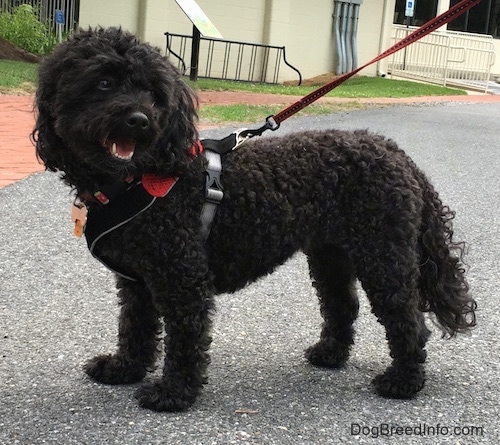
Jazz the curly-coated Havanese with his coat groomed short.
The crew at MistyTrails Havanese—Reo at 1.5 years, Conchita at 1 year, Purdy at 4 months, Lucy and Splash at 3 months, Sebastion at 3 years and Catreeya at 4 years old
"We were not looking for a dog but when we came across Vlady we both knew right away that we were meant to be his parents. Prior to that time we had never heard of a Havanese, or the temperament of the breed. We were, however, won over by this pup’s playful, calmness and affection. We liked that he would still play with lots of enthusiasm, yet relax completely when he was picked up. So we went with our gut feeling and decided to take him home. He has been a complete joy to our family. He has been adopted by our two cats, both 8 years old, and he is an amazingly quick learner. Despite of a few sleepless nights, we have all adapted quickly to the newest member of our family. He enjoys his walks, playtime and naps. He is adored by all who have met him and he gets along great with all other dogs. He has a great temperament and a sweet personality and we are very lucky to have him in our family."
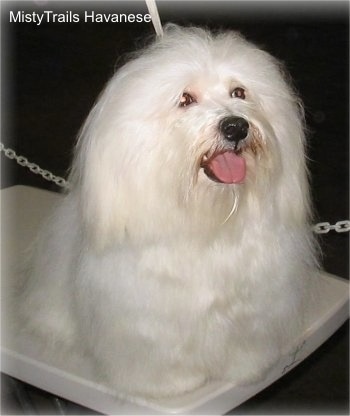
Zorro, submitted by MistyTrails Havanese—Zorro's sire is from Spain. This dog completely conforms to the CKC and AKC standard for Havanese.
Examples of chocolate parti, white, blue pewter, and black Havanese. Two of the rarest colors in the Havanese breed are the blue pewter and chocolate parti. Those colors and the black were originally not part of the breed standard. Photo courtesy of MistyTrails Havanese and Elite Havanese
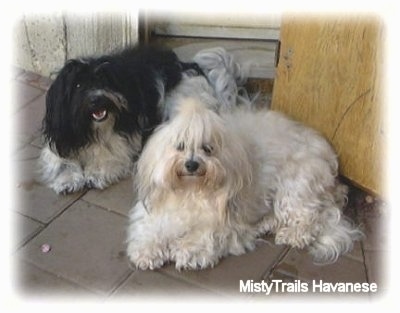
Pablo with Salida; Salida is a pure Cuban Havanese, imported and owned by Alida Wasmuth, photo courtesy of MistyTrails Havanese
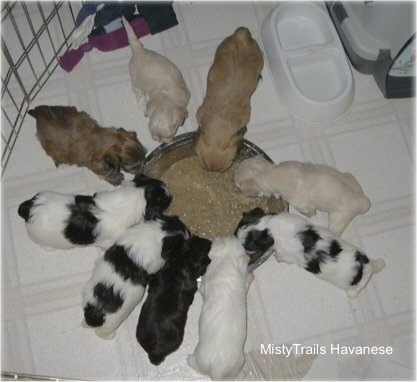
Havanese can have one puppy in a single litter; the normal is 3, 4, or 5 puppies. Six is considered a large litter for a Havanese. I have had several 7-puppy litters, a couple 8-puppy litters and one 9-puppy litter. Photo courtesy of MistyTrails Havanese
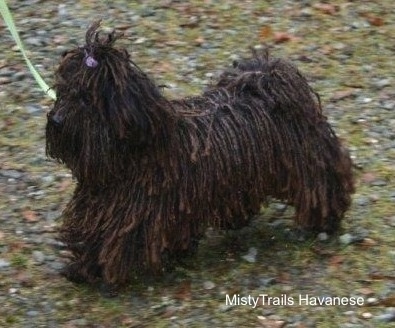
Corded Havanese MBIS CKC Grand Ch. Ex/AKC/Intl Champion Eddie Murphy at MistyTrails CGN, #1 Dog in Canada Photo courtesy of MistyTrails Havanese Aug 2012
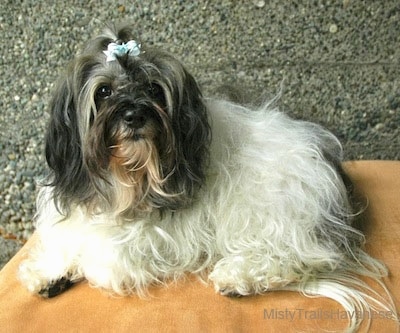
Catreeya at 10 years old—"She is the mother of 11 Champion puppies and won the Best Veteran in Specialty Show. She was bred by MistyTrails Havanese." Owned and loved by Steven Ballantyne
Breeders
The Material contained herein may not be reproduced without the prior written approval of the author. Contents & Graphics Copyright © Dog Breed Info Center® (C) 1998- . All Rights Reserved. Our work is not Public Domain.





Комментариев нет:
Отправить комментарий